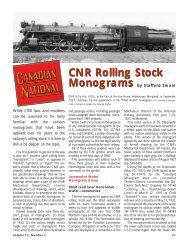CN LINES V12N3 - Canadian National Railways Historical Association
CN LINES V12N3 - Canadian National Railways Historical Association
CN LINES V12N3 - Canadian National Railways Historical Association
You also want an ePaper? Increase the reach of your titles
YUMPU automatically turns print PDFs into web optimized ePapers that Google loves.
While <strong>CN</strong>R fans and modelers<br />
can be assumed to be fairly<br />
familiar with the various<br />
monograms that have been<br />
applied over the years to the<br />
railway’s rolling stock, it is time to<br />
drill a bit deeper on the topic.<br />
The first question to get out of the way<br />
is why do I insistent upon calling them<br />
“monograms” or “crests”, as opposed to<br />
“heralds”, “symbols”, or “logos”? The reason<br />
is simple: that is what the <strong>CN</strong>R consistently<br />
called these graphic elements in<br />
the specification drawings that we have<br />
been able to locate. It is these specification<br />
drawings which were a part of the <strong>CN</strong>R<br />
Mechanical Department’s H-series<br />
(Headquarters) of drawings, which, when<br />
available, allow us to determine the introduction<br />
dates of a specific monogram, its<br />
purpose(s), size, colors, dates of alterations,<br />
as well as anything else that seems to be<br />
critical to know.<br />
Viewed broadly, there were three distinct<br />
groups of monograms: (1) those<br />
based in the locomotive wafer monogram<br />
of 1932; (2) the various freight service<br />
maple leaf crests or monograms from<br />
1943; and (3) the round diesel locomotive<br />
<strong>CN</strong>R Rolling Stock<br />
Monograms<br />
Monograms by Stafford Swain<br />
<strong>CN</strong>R U-2-a No. 6100, at the Fair of the Iron Horse, Halethorpe, Maryland, in September<br />
1927, illustrates the first application of the “Tilted Wafer” monogram.—Al Paterson Collection;<br />
Colour monogram graphics by George Walker<br />
and passenger-service, including passenger<br />
service-assigned steam locomotive, monograms<br />
from 1949 onwards.<br />
While I will try to mention the existence<br />
of any similar/parallel monograms of the<br />
U.S. subsidiaries (GTW, CV, GT-NE<br />
Lines, and DW&P), a similar chronological<br />
review of each of these individual railway’s<br />
monograms is a discrete topic worthy<br />
of true expert authorship for each railway.<br />
All of these various graphics were supplanted<br />
by the <strong>CN</strong> symbol, which was<br />
unveiled in the final days of 1960.<br />
This presentation will address each of<br />
these three groups in their respective<br />
chronological order and close with a few<br />
comments on the symbol.<br />
Locomotive Wafer<br />
Monogram Group<br />
Tilted (and later Horizontal)<br />
Wafer—Locomotive<br />
The first monogram to appear on <strong>CN</strong>R<br />
rolling stock was the tilted rectangular<br />
wafer on steam locomotive tenders. It<br />
seems to have first appeared in builder<br />
photographs of the very first <strong>CN</strong>R<br />
Northern-Type (4-8-4) locomotive, U-2-a<br />
subclass No. 6100. This locomotive was<br />
turned out by the <strong>Canadian</strong> Locomotive<br />
Company (Kingston) in early June 1927<br />
and was displayed at a convention of the<br />
Mechanical Division of the American<br />
Railway <strong>Association</strong> from June 7–10,<br />
1927, in Montreal.<br />
This initial version of the tilted-wafer<br />
monogram seems to have been rendered in<br />
a White paint on the Black coal bunker<br />
with no outline pinstriping visible in the<br />
photos. This version of the monogram<br />
apparently was done without the creation<br />
of formal drawing by the <strong>CN</strong>R’s<br />
Mechanical Department. Of interest, the<br />
boiler jackets of these earliest Northerns<br />
were painted a dark gray, per a Railway<br />
Mechanical Engineer article of August 1927<br />
(pp. 536-540).<br />
During the depths of the Depression<br />
(May 10, 1932), the <strong>CN</strong>R issued drawing<br />
3H-17470 for the “Standard<br />
Monogram Used on Locomotive<br />
Tenders, Electric Locomotives and Oil-<br />
Electric Switchers.” Drawing 7H-14148<br />
“Lettering & Numbering—Steam<br />
Locos” of March 27, 1919, (a <strong>CN</strong>R<br />
“Standard”) was revised (essentially<br />
redrawn and re-issued) on May 13, 1932,<br />
to incorporate the placement of the wafer<br />
monogram on various tender styles. No.<br />
3H-17470 thus noted that 7H-14148<br />
was to be referred to for placement/location<br />
of lettering and numbering.<br />
The monogram was to be placed so that<br />
the lower right-hand corner was located<br />
5-1/2 inches higher than the lower left-<br />
Volume 12, Number 3 21



